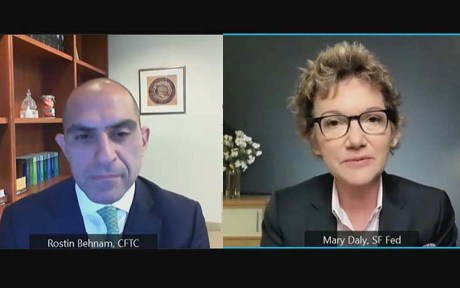
Fireside chat between CFTC Acting Chairman Rostin Behnam and San Francisco Fed President Mary Daly
On November 17, 2021, the New York Fed hosted the seventh annual Conference on the U.S. Treasury Market. The one-day event, held virtually, was co-sponsored by the U.S. Department of the Treasury, the Federal Reserve Board, the U.S. Securities and Exchange Commission (SEC), and the U.S. Commodity Futures Trading Commission (CFTC). The agenda featured one panel on the effects of sudden changes in investor positioning, and two panels discussing proposals to strengthen Treasury market resiliency and improve market intermediation from various public and private sector perspectives. Speeches touched on recommendations from a recent progress report by the Inter-Agency Working Group for Treasury Market Surveillance (IAWG), and efforts to improve market resilience by reforming market structure and regulation. Finally, a fireside chat discussed the importance of increasing diversity of experiences and perspectives within the public and private sectors.
Keynote Addresses
The conference began with a keynote address from New York Fed President John Williams focusing on the importance of learning from prior Treasury market disruptions to prepare for potential future shocks. He noted that unpredictable strains on the Treasury market will inevitably occur, and in some cases, these stresses may fail to self-correct absent official sector intervention. President Williams also suggested that improvements to market resiliency are required to prevent the reoccurrence of recent disruptions and to ensure the system is able to successfully navigate unforeseeable shocks. Specifically, he encouraged the consideration of proposals to prepare the market for unanticipated challenges in ways that limit the need for official sector intervention when they inevitably occur.
SEC Chair Gary Gensler gave a keynote address in which he referenced the long history of efforts to improve the structure and functioning of the Treasury market. He noted his requests for staff to make recommendations for how principal trading firms might be appropriately registered as dealers with the SEC, to consider enhancing trade platform oversight by ensuring various types of trading platforms are registered with the SEC, and to improve data quality by enhancing reporting through FINRA’s TRACE and the SEC’s Form PF. Chair Gensler also mentioned having asked staff to examine expanded central clearing and provide recommendations on whether to require clearing agency members to bring both sides of their trades within a clearing agency, to identify ways to enhance the SEC’s Covered Clearing Agency Rules, and to examine other means for the SEC to ensure broader access to clearing.
Under Secretary for Domestic Finance Nellie Liang also gave a keynote address in which she discussed the Treasury Department’s debt management decisions since March 2020 in the context of its “regular and predictable” framework. She also noted episodes of imbalances between the demand for Treasury liquidity and the more limited capacity of intermediaries to respond. Under Secretary Liang highlighted the progress report recently released by the IAWG—a body comprised of staff from the five organizations hosting the conference—and she indicated that agency staffs identified six principles as useful in guiding Treasury market policy in order to achieve the official sector’s objectives. While steps related to specific policy areas to strengthen the market’s resilience are already under way, including efforts to increase the quality of data available to the official sector, she noted that other workstreams are at earlier stages of consideration.
Fireside Chat
There was also a wide-ranging fireside chat between CFTC Acting Chairman Rostin Behnam and San Francisco Fed President Mary Daly. Topics included the importance of having a diversity of experiences and perspectives within organizations, with both agreeing that additional efforts should be made to expand diversity in both the public and private sector. Acting Chairman Behnam and President Daly also discussed the rapidly changing nature of the technological landscape and the interconnectedness of the financial system. Finally, Behnam highlighted the potential for financial markets to accelerate the management of risks from climate change, and he and Daly noted significant progress in the industry’s efforts to transition away from LIBOR to a more robust reference rate.
Panel Discussions
There were three panels during the day. The first, hosted by Deputy Assistant Secretary of the Treasury Brian Smith, provided a discussion of how sudden changes in investor positions can impact market functioning. The panelists included representatives of a relative value fund, an asset manager, a broker-dealer, and a foreign official institution. The panel discussed the critical role of the official sector response to the significant unwind of levered funds and the unprecedented demand for cash Treasuries during March 2020. The panel also discussed the need for a holistic approach to improving the resiliency of the market by ensuring robust sources of liquidity in advance of stress episodes, as well as the importance of improving data collection to inform official sector decision-making.
The second and third panel focused on recommendations to improve Treasury market resiliency as well as market intermediation and liquidity provisioning. The second panel was moderated by William Dudley, Senior Research Scholar at Princeton University, and was comprised of academics and representatives of think tanks. Among the recommendations discussed were the proper role of standing repo facilities in providing reliable access to liquidity, as well as the risks and benefits associated with broadening access to these facilities. The panelists discussed potential changes to the Supplementary Leverage Ratio and noted that such changes could meaningfully support intermediation. Finally, panelists noted the risk management and transparency gains that could result from expanded central clearing of Treasuries, while also noting the potential concentration risk associated with relying on a clearinghouse.
The third panel was hosted by System Open Market Account Manager Lorie Logan, and featured panelists from a variety of private sector institutions who provided their perspective on these recommendations to improve Treasury market resiliency. The discussion highlighted benefits of central clearing, such as increased balance sheet efficiency, reduced counterparty risk and enhanced transparency, but also acknowledged the concentration risk associated with expanded central clearing. Participants suggested that certain central clearing models could enhance adoption by reducing frictions. Some participants saw benefits to market liquidity from all-to-all trading, while others felt that customer relationships improved execution, particularly in times of stress. Participants felt that regulations should allow for an expansion of intermediation activity when needed and be congruent across firms. Panelists supported greater transparency in a manner that enhanced liquidity. By bringing together a variety of views, the panel shed light on the interconnected nature of proposals to improve Treasury market resilience.

Michael Fleming is a vice president in the Federal Reserve Bank of New York’s Research and Statistics Group.

Frank Keane is a senior policy advisor and vice president in the Bank’s Markets Group.

Daniel Weitz is a policy and market analysis associate in the Bank’s Markets Group.
How to cite this post:
Michael Fleming, Frank Keane, and Daniel Weitz, “At the New York Fed: Seventh Annual Conference on the U.S. Treasury Market,” Federal Reserve Bank of New York Liberty Street Economics, December 3, 2021, https://libertystreeteconomics.newyorkfed.org/2021/12/at-the-new-york-fed-seventh-annual-conference-on-the-us-treasury-market.html.










 RSS Feed
RSS Feed Follow Liberty Street Economics
Follow Liberty Street Economics